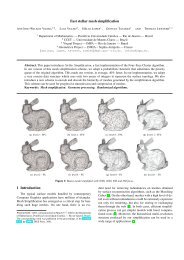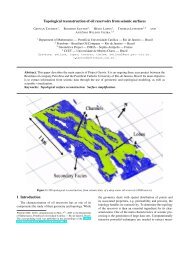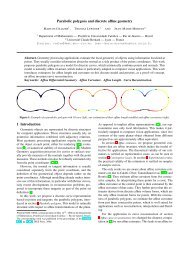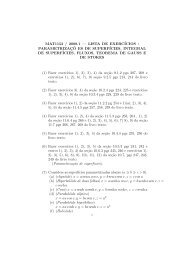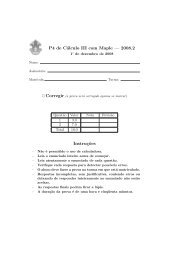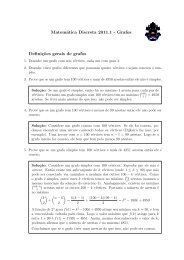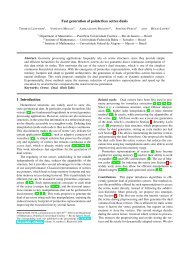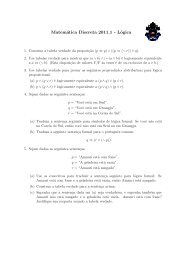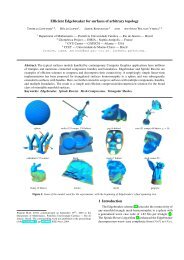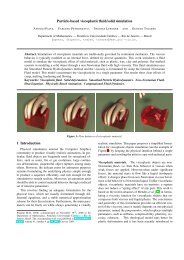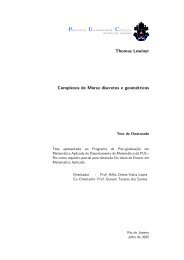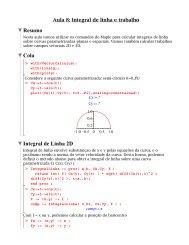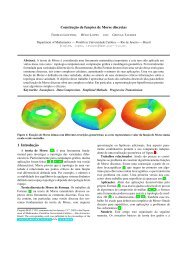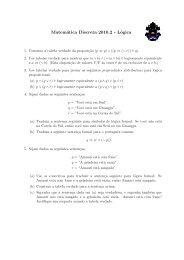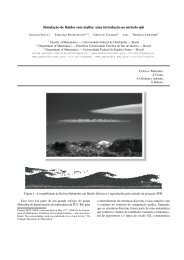Particle-based non-Newtonian fluid animation for melting ... - PUC-Rio
Particle-based non-Newtonian fluid animation for melting ... - PUC-Rio
Particle-based non-Newtonian fluid animation for melting ... - PUC-Rio
Create successful ePaper yourself
Turn your PDF publications into a flip-book with our unique Google optimized e-Paper software.
7 <strong>Particle</strong>-<strong>based</strong> <strong>non</strong>-<strong>Newtonian</strong> <strong>fluid</strong> <strong>animation</strong> <strong>for</strong> <strong>melting</strong> objects<br />
the next level and repeat the process until we reach the tree<br />
leaves containing particles. Now we check if each particle is<br />
inside of the support domain of the current particle i. If it is<br />
we record it as a particle neighbor. The complexity of this<br />
tree search method is of order O(n log(n)), n being the total<br />
particle number.<br />
(c) Rendering<br />
The tracking of the <strong>fluid</strong> free surface is done by rendering<br />
an isosurface from the SPH approximation of its characteristic<br />
function:<br />
χ (x) =<br />
n∑<br />
j=1<br />
m j<br />
ρ j<br />
W (x − x j , h)<br />
where the isovalue is in the range [0, 1].<br />
We use an efficient and robust implementation of the<br />
marching cubes algorithm [21] to generate the triangle mesh<br />
<strong>for</strong> the isosurface. To improve the evaluation at the grid<br />
nodes we use the same hierarchical data structure <strong>for</strong> search<br />
neighboring particles.<br />
The <strong>animation</strong>s of Figures. 1 and 6 were rendered using<br />
the open–source ray tracer POV–Ray (http://www.<br />
povray.org).<br />
(d) Results<br />
We tested the method described in this paper on simple<br />
models. The example of Figures. 1 and 2 simulates the <strong>melting</strong><br />
of the Stan<strong>for</strong>d bunny with 9727 particles. The simulation<br />
is initialized with a linear gradient of temperature such<br />
that the ears melt while the body remains cold and solid. The<br />
visual result of Figure 1 matches the intuition of the process.<br />
Moreover, the physical behavior is coherent, especially since<br />
one of the ears gets colder when touching the body, while the<br />
other one remains hot (see Figure 2).<br />
In this work, we combined many advanced discretisation<br />
schemes to guarantee the stability of the simulation. The<br />
SPHmethod already offers simple handling of topological<br />
singularities, as <strong>for</strong> the 10000 particles simulation of Figure<br />
3. This ef<strong>for</strong>ts result impressively when simulating the<br />
only flowing part of the <strong>melting</strong>, as on Figure 5. In that case,<br />
all the 6976 particles start above the <strong>melting</strong> point, and flows<br />
as a <strong>non</strong>–<strong>Newtonian</strong> <strong>fluid</strong>. The good handling of viscosity in<br />
SPH techniques allows very realistic results. For example,<br />
the head of the gargoyle remains well defined even when almost<br />
completely melted.<br />
Finally, the proposed adaptive time step allows efficient<br />
simulations. For example, the <strong>melting</strong> of the Sibgrapi logo<br />
of Figure 6 used 12900 particles, i.e. more particles than <strong>for</strong><br />
the bunny. However, it required less execution time <strong>for</strong> the<br />
simulation (see Table 2). This is due to the lower density of<br />
the model, which allowed bigger time steps.<br />
5 Conclusions and future works<br />
This paper proposed a physical simulation <strong>for</strong> <strong>melting</strong><br />
viscoplastic objects. Our simulation relies on the SPH<br />
framework, and implements the General <strong>Newtonian</strong> Fluid<br />
model <strong>for</strong> viscoplastic <strong>fluid</strong>s. It is further enhanced in numerical<br />
stability by adapted discretisation of the Navier–Stokes<br />
equation terms, and by a stable Laplacian operator <strong>for</strong> the<br />
heat equation. The effectiveness of the method is illustrated<br />
on simple examples which match the physical laws, leading<br />
to an efficient scheme <strong>for</strong> both <strong>animation</strong> and simulation purposes.<br />
This work can be improved mainly in two directions. On<br />
one side, the inner nature of SPH systems permits a straight<strong>for</strong>ward<br />
parallelization of the algorithm, which would increase<br />
the possible number of particles used during the simulation.<br />
On the other side, the rendering remains a fundamental<br />
part <strong>for</strong> <strong>animation</strong> purposes. The isosurfacing approach<br />
may be complemented by advanced rendering techniques<br />
during the simulation, in order to produce the final <strong>animation</strong><br />
directly.<br />
Animation Number of Time per<br />
particles iteration<br />
Bunny 9727 0.94s<br />
Chair 10000 0.75s<br />
Gargoyle 6976 1.06s<br />
Sibgrapi 12900 0.92s<br />
Table 2: Average timings of the example <strong>animation</strong>s running on<br />
Pentium 4 – 2.4 GHz. Note that in the Gargoyle simulation, all<br />
particles were <strong>fluid</strong>s.<br />
Acknowledgments<br />
We would like to thank Prof. Paulo Roberto Mendes (Department<br />
of Mechanical Engineering, <strong>PUC</strong>–<strong>Rio</strong>) <strong>for</strong> suggesting<br />
us to use his viscoplastic <strong>fluid</strong> model. The authors are<br />
members of Matmidia laboratory at <strong>PUC</strong>–<strong>Rio</strong> which is sponsored<br />
by CNPq, FAPERJ and Petrobras.<br />
References<br />
[1] J. D. Anderson. Computational Fluid Dynamics.<br />
McGraw-Hill, 1995.<br />
[2] M. Carlson, P. Mucha, B. Van Horn III and G. Turk.<br />
Melting and flowing. In Symposium on Computer Animation,<br />
pages 167–174, 2002.<br />
[3] S. Clavet, P. Beaudoin and P. Poulin. <strong>Particle</strong>-<strong>based</strong> viscoelastic<br />
simulation. Symposium on Computer Animation,<br />
pages 219–228, 2005.<br />
Preprint MAT. 15/06, communicated on May 14 th , 2006 to the Department of Mathematics, Pontifícia Universidade Católica — <strong>Rio</strong> de Janeiro, Brazil.



